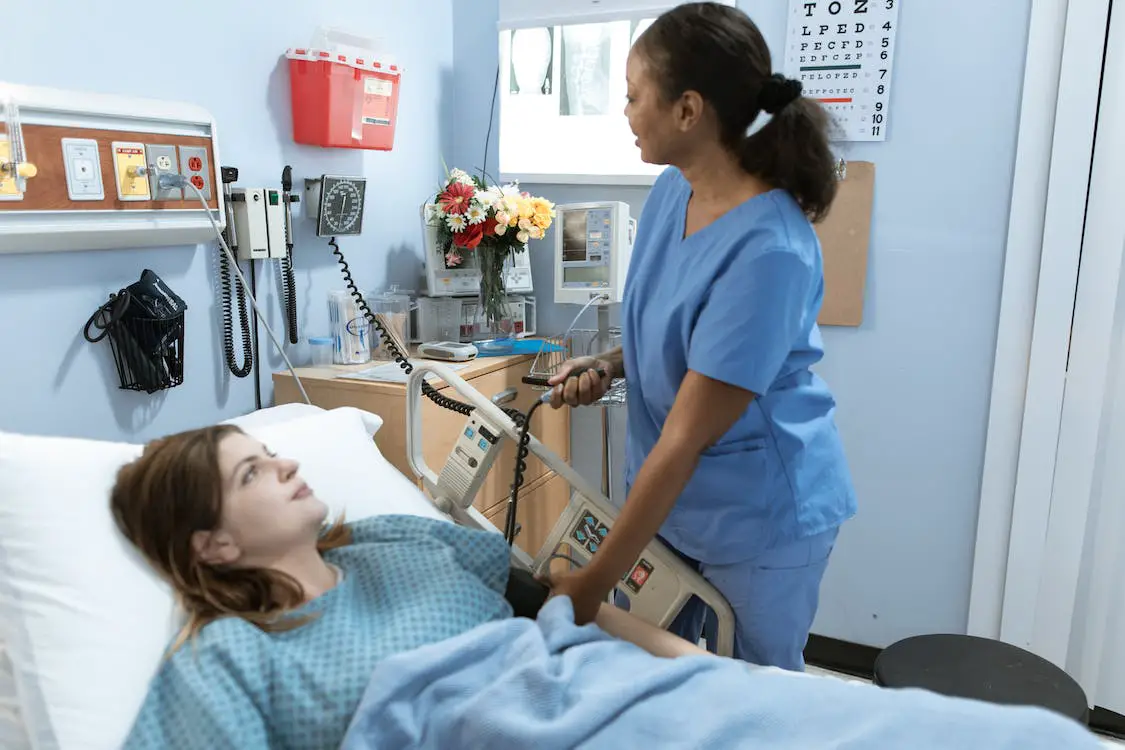Last Updated on 9 months by Francis
Contents
Enhancing Patient Care: The Applications Of Infrared Technology In Nursing
The nursing field has rapidly evolved over the past few decades and has been greatly aided by technological advancements. Innovations in the form of electronic health records and telemedicine have allowed nurses to provide safer, more efficient, and higher-quality patient care.
One technology that holds great promise for transforming nursing practice is infrared imaging. Infrared cameras can detect subtle variations in temperatures, including skin and body heat, and provide valuable information that can be used for a wide range of clinical applications. As nursing continues adopting new tools that enhance patient outcomes, infrared technology is bound to have a significant impact.
Let’s understand how infrared has the potential to become an indispensable nursing tool for improving patient care.
Historical use of infrared in medicine
The first infrared detectors were developed in the 1800s, but medical applications didn’t emerge until the 1950s when military research created more sophisticated infrared devices. One of the earliest pioneers was Dr. Ray Lawson, who used infrared imaging to detect breast cancer by identifying abnormal heat patterns in the 1960s.
With advances in thermography technology, infrared cameras became more affordable and portable by the 1990s. Research on clinical applications flourished, and nurses and physicians began to use thermography for vascular assessments, tumor detection, arthritis evaluation, circulatory problems, and many other conditions.
Today, a DNP prepared nurse explores medical advancements and analyzes how technologies like infrared imaging have evolved over the years and what their implications are in modern patient care. While there were some challenges in standardizing protocols and interpreting thermograms, this technology has continued to gain traction in medicine. Today, it is a widely used diagnostic tool in neurology, oncology, vascular surgery, and sports medicine, and nurses need to become familiar with its applications so they can enhance patient care.
What is infrared technology?
Infrared energy refers to the part of the electromagnetic spectrum with wavelengths longer than those of visible light but shorter than radio waves. All objects that have a temperature emit some amount of infrared radiation; this amount is directly related to their molecular composition and temperature. Infrared detectors contain sensors that detect the smallest differences in infrared emissions from an object’s surface. This information is translated into thermal patterns and displayed as body heat maps, with precise temperature measurements at any point.
Unlike other imaging techniques, infrared technology is non-invasive and involves no ionizing radiation. Infrared cameras can provide real-time physiological data, with some systems capturing up to 60 frames per second. This makes it ideal for continuous and safe monitoring of patients.
Benefits and applications of infrared technology in nursing
Heat can act as an early warning sign for potential problems, and detecting these issues sooner allows for earlier intervention and improved patient outcomes. This assists nurses in making informed decisions and providing better care to patients. Here are some known benefits and applications:
-
Infrared thermography: Monitoring temperature variations
One of the most common applications of infrared technology in nursing is tracking temperature changes across the body. As an adjunct to routine vital signs monitoring, infrared thermography provides far greater temperature detail that can signal problems that require intervention. For instance, asymmetric thermal patterns or abnormal hot/cold spots can indicate inflammation, circulatory issues, skin infections, and other conditions.
Nurses can perform whole-body or localized infrared scans to identify signs of infection as part of ongoing patient surveillance. Frequent infrared monitoring also helps detect fever early, which enables faster treatment. Localized thermography of the eyes, ears, nose, and mouth assists in identifying infections before other symptoms manifest.
Infrared cameras can also continuously monitor wound sites and surgically repaired areas for abnormal heat patterns that might indicate an infection.
-
Wound assessment and management
Infrared images clearly show the thermal characteristics of wounds, with warmer colors indicating increased blood flow and cooler colors suggesting reduced perfusion. This assists nurses in targeting interventions to wound areas that need it most. Since adequate blood supply is crucial for healing, infrared cameras can identify tissue at risk of necrosis due to poor blood supply. This allows earlier intervention to improve local circulation. It is also an excellent tool for remotely monitoring wounds to minimize disruption to fragile tissue.
-
Neurological assessments
Neurology uses infrared thermography to assess patients with potential neural issues. Skin temperature patterns often correlate with various neurological problems. For instance, complex regional pain syndrome (CRPS), i.e., excessive and prolonged pain and inflammation after a leg or arm injury, exhibits abnormal thermal asymmetry, which can be identified on infrared imaging.
For patients with nerve disorders, infrared imaging can identify temperature variations along the spine suggestive of abnormal sympathetic nervous activity. It is also being studied to assess the severity of multiple sclerosis and Parkinson’s disease.
With further research, nurses can eventually use infrared neuroimaging to aid in monitoring neural disease progression and response to treatment.
-
Vein detection
Locating veins for procedures like IV insertions can be challenging for patients with small veins, dark skin tones, or obesity. Infrared technology makes veins more visible by detecting thermal differences between blood vessels and surrounding tissue.
Handheld infrared vein viewers provide real-time imaging of subcutaneous blood vessels, with colors indicating depth and size. This improves first-stick success for IV placement and reduces patient discomfort from repeated failed attempts. This decreases the risk of hematomas or bad bruises forming on patients’ skin, ultimately leading to better patient satisfaction and decreasing procedure time.
-
Reduced hospital-acquired infections
Hospital-acquired infections prolong hospital stays and increase patient morbidity and mortality. Infrared thermography can aid infection control efforts by identifying early infection temperature changes.
Monitoring wound sites and surgical incisions with infrared cameras facilitates early detection of infection based on abnormal heat patterns. Routine infrared scans of patients also assist in identifying early fever spikes before they escalate. This allows for faster treatment.
By performing contactless infrared monitoring, nurses can also reduce cross-contamination risks. Infrared also limits patient discomfort and disruption compared to direct body temperature measurements. With its ability to detect early signs of infection, infrared technology is a valuable tool for reducing hospital-acquired infections.
-
Application in oncology nursing
Infrared thermography is increasingly used in oncology to identify temperature changes that may indicate tumor presence and response to cancer treatments. Several studies have found that many cancers show variance in skin temperature due to factors like increased blood flow and cell division.
Infrared imaging can help oncology nurses detect early skin temperature changes associated with tumor development. It also assists in tracking patient response to chemotherapy and radiation based on tumor heat patterns. Infrared provides continuous, non-invasive monitoring without repeated exposure to ionizing radiation from CT scans.
While more research is needed, infrared also shows promise in assessing tumor margins during cancer surgery. By distinguishing between healthy and abnormal thermal patterns, it can help guide tumor excision. Overall, infrared technology expands the capabilities of oncology nurses for improved cancer screening, treatment monitoring, and surgical guidance.
-
Applications in pediatric nursing
Infrared thermography provides pediatric nurses with a patient-friendly option for temperature monitoring and physiological assessments for kids. Unlike rectal, oral, or axillary readings, infrared is entirely non-invasive. It also enables continuous monitoring without disturbing young patients.
For infants, infrared cameras can identify fever and signs of infection, like increased joint temperature. It may detect early inflammation in conditions like arthritis and sports injuries based on abnormal heat patterns. It is also useful for identifying circulatory or vascular disorders.
Since the technology is contactless and does not involve needles, children feel less distressed during doctor visits and checkups. This technology also helps overcome challenges like getting kids to keep thermometers in their mouth or armpit long enough for accurate readings.
How DNP-prepared nurses are pioneering its use
As leaders, DNPs are educating RNs on the clinical applications of infrared and providing training on using this technology. Their in-depth understanding of research helps identify how infrared thermography can address specific patient needs. DNPs also conduct studies examining infrared imaging in areas like wound assessment, infection detection, and neurological monitoring.
By spearheading evidence-based protocols for infrared use in medical units, DNPs ensure this technology is implemented safely and effectively. With their systems-level perspective, DNPs advocate for procuring infrared devices and adopting supportive policies across their organizations.
Many nurses who are into research and development also write scholarly articles, present at conferences, and obtain grants to advance infrared research. Their real-world perspective provides the clinical context to refine infrared approaches for patient benefit.
Training and skill development for nurses
Proper training and skill development are essential for nurses to make good use of infrared technology in providing patients with better care. Education should include understanding fundamental infrared principles, their clinical applications, safe use protocols, image acquisition, data interpretation, and ethical considerations. Hands-on training with infrared devices is important to ensure nurses utilize this technology in their work.
Nursing schools can incorporate infrared thermography into their curricula to equip the next generation of skilled RNs, NPs, and DNPs with relevant information. For current nurses, continuing education programs and professional development courses can introduce nurses to infrared imaging and its applications in patient care. Experienced nurses should pursue advanced certification courses to gain specialized expertise in infrared wound imaging, neurological assessments, or oncology applications.
Ethical considerations and patient privacy
While infrared thermography provides many patient benefits, ethical concerns regarding privacy, confidentiality, and appropriate use must be addressed. Nurses should get the patient’s consent before using infrared devices to collect data, and patients should be informed about how their data is stored and shared.
Nurses must also protect patient dignity and comfort while using infrared imaging devices. Images should be obtained only for appropriate clinical purposes in a professional manner. Protocols are needed regarding the retention and distribution of patient infrared data.
There is also a risk of misinterpreting thermal patterns or overstating what infrared can diagnose. Nurses require training to avoid over-extrapolating infrared results. With thoughtful policies and education on ethical principles, nurses can implement infrared technology responsibly that safeguards patients.
Challenges and limitations
While infrared thermography is gaining popularity in healthcare, challenges and limitations still impact its widespread adoption. The initial cost of high-quality infrared detectors, cameras, and projectors can be substantially high for facilities with limited financial resources. Interpreting complex thermal patterns requires specialized training that nurses may currently lack. There is also a need to develop robust protocols and standards for image acquisition and analysis.
Environmental factors like air currents, humidity, and ambient temperatures can influence skin surface heat patterns, confounding images. The technology may have reduced utility in certain patient types, like patients with vascular disorders or skin grafts. It is important to understand that this technology can’t entirely replace traditional diagnostic methods and is impacted by other treatments patients receive.
However, many limitations are being addressed with ongoing improvements in infrared technology and clinical research.
The future of infrared technology in nursing
Infrared thermography is expected to become a prominent clinical tool to improve nursing practice. Ongoing technological advances will improve camera resolution and image analysis software. Integration with electronic records will enable infrared data to be incorporated into clinical decision support systems.
With more research, new infrared applications will emerge, including remote monitoring from home and telehealth. Nurses will be able to identify subtle physiological changes remotely and enhance diagnostic testing. Machine learning will assist nurses in extracting clinically meaningful patterns from thermal images.
Nursing education will need to integrate substantive infrared content into curricula. As nurses gain greater access to this technology, they can fully harness its capabilities to provide safer, higher quality, and more efficient patient care.
Conclusion
The applications of infrared technology in nursing continue to grow as research unlocks its full potential. From wound assessments to infection control, infrared imaging provides invaluable physiological insights through detailed thermal mapping of the body. This powerful monitoring tool allows early detection of problems, prompting timely interventions that improve patient outcomes.
Education on clinical use and their ethical implementation is essential for nurses to consider. DNP-prepared nurses can make valuable contributions by pioneering IR applications and integrating technology into mainstream practice. With increasing adoption, infrared thermography promises to transform nursing care in the 21st century.








